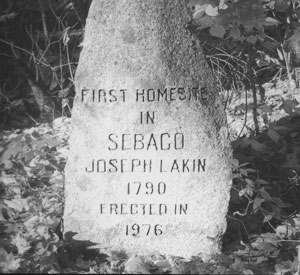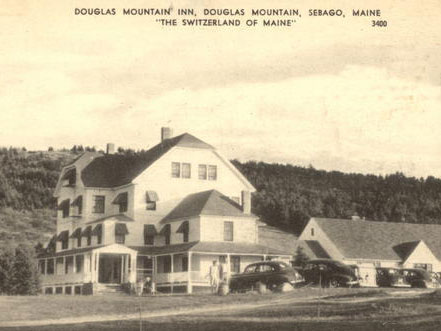History of Sebago
Early History: 1774 – 1826
Located on the Northwest shore of Sebago Lake, the Town of Sebago was incorporated on February 10, 1826. It was originally part of the Town of Baldwin, with parts of Denmark and Naples added later.
Baldwin, originally known as Flintstown, was established by a grant to the survivors of the company of Captain Flint of Concord, Mass in 1774. This was not the first grant to Captain Flint; an earlier grant was given in 1735, but abandoned in 1751 when the New Hampshire border was established. Even this grant nearly failed; the conditions to establish 30 families were not met by 1780, and the time period was extended 6 years. They eventually met the conditions "by the skin of their teeth" and had to "strain a point" to show that the grant conditions had been fulfilled.
Baldwin was incorporated on June 23, 1802, named for one of the early settlers, Loammi Baldwin. The town was "destitute of a meeting house and minister", indeed, the twenty miles of county roads that had been constructed were in a "dangerous condition for teams, carriages, or horses."
The earliest inhabitants of the northern portions of Baldwin were lumberjacks and woodsmen, who left the area as soon at the first growth of pine was cut. The first permanent settlers of this area were Joseph Lakin and Jacob Howe. Mr. Howe carried the first mail from Bridgton; there are no records of his family remaining in the area. Joseph Lakin came from Groton, Mass. in 1790 and built a cabin off of what is now the Peabody Pond Road. He returned later with his family and goods, crossing Sebago Lake by boat and made his way to the spot where he hoped a public road would eventually be built.
In 1793 William Fitch also came from Groton, and settled in the Sebago portion of Baldwin. He built the first grist-mill and sawmill on the pond at East Sebago, and the first lumber mill on the Northwest River. Fitch was one of the first Selectmen in Baldwin in 1802, and when Sebago was incorporated in 1826, he was one of the first selectmen in Sebago, also in 1827 and 1829. He was the first postmaster, and the first town clerk. His wife came from Groton on horseback, with their son, William, in her arms. Several other members of the Fitch family came to the area from Groton, building sawmills and opening a store.
Sebago was incorporated as a town in 1826, as a result of a petition signed by seventy five of the first families of Sebago. A part of Denmark was added in 1830, and a few lots at the mouth of the Muddy River were given to Naples in 1851.
Other early settlers who were clearing the land and establishing homesteads before 1826 were James Babb, George Douglas, Samuel Dyer, James Gray, William Haley, William Irish, BF Knapp, Isaac Larrabee, John Libby, Nathaniel Martin, John Meserve, Daniel Nason, Oliver Pike, Leander Poor, David Potter, John Pugsely, William Sanborn, John Shaw, Scolly Usher. The complete list of the seventy-five families who signed the petition for incorporation of the town of Sebago in 1826 can be found here.
The early settlements were grouped together within the rural township, creating small villages within the larger town. These neighborhoods included New Limington (Convene), Douglas Hill, East Sebago, Hillside, Back Nippen, The Folly, Long Beach, North Sebago, Sebago Center (Mud City), and West Sebago.
The local economy was first based on lumbering and farming. With the depletion of first growth White Pine, agriculture became more important. However, rocky soils limited the productivity of farms. The manufacture of barrels, primarily for shipment to the West Indies for molasses, became an important industry until the mid-1800s.
Sebago: 1800 – 1900s
The following description of Sebago in the 1800’s is from the “History of Sebago, Maine” in A Gazetteer of the State of Maine by Geo. J. Varney (published by B. B. Russell, 57 Cornhill, Boston 1886). This description captures the hard work involved for the early settlers in creating productive farmsteads and establishing early industries.
“About 1000 acres from Denmark was annexed in 1830; and 400 acres have since been added from Baldwin; but in forming Naples, in 1834, 4,700 acres were taken from Sebago. The surface of the town is very uneven, and generally rocky. It was a severe task to clear up a farm in this rough region; but the soil was strong and repaid the industrious with abundant crops. The building and maintaining of roads among the rocky hills amid the construction of bridges over its rapid streams has always been a severe tax upon the inhabitants; but the work has been well performed. The highest eminences in Sebago are Saddleback Mountain, on the southern border, Peaked Mountain, in the eastern part, and Tiger mountain in the north-eastern. Brown's and Perley ponds,— the largest three-fourths of a mile in length—lie within town limits. On its borders are Sebago Lake, Peabody, Great Hancock, Hancock, and South-East ponds. The principal streams are North-West River, Mill Brook and Sandy Beach Brook. The chief settlement is on Mill Brook, near the centre of the town,-constituting Sebago village. The principal manufactures are long and short lumber, shooks and boots and shoes.
"The town has Congregationalist, Baptist, Gen. Baptist, and Union churches. Sebago has nine public schoolhouses, valued at $1,600. The estates in 1870 were valued at $175,550. In 1880 they were valued at $183,095. The population at the same date was 803. The census of 1880 increases it to 808.”
Additional information on this time period (Wikipedia) looks ahead to the emerging importance of recreation and tourism towards the end of the 19th century into the early 20th century:
“In 1832, the Cumberland and Oxford Canal opened, increasing trade between Sebago Lake and Portland. In the early 1870s, the Portland and Ogdensburg Railroad carried tourists and freight to Sebago Lake Station in Standish, where steamboats took them to various landings around the lake. Inns, hotels and summer camps opened, and the town became a recreation area, which it remains today.”
The emergence of Douglas Mountain as a well-known destination for outdoor recreation and the start of the establishment of summer camps along the shores of Sebago Lake around 1900 are examples of the growing significance of tourism to the economy and identity of the town in the early 1900’s.
Improved transportation in the second half of the nineteenth century led to the establishment of Sebago as a summer vacation spot. Boats and trains from New York and Boston provided transportation to Portland. From there, rail service took passengers to Sebago Lake Station in Standish, where they boarded boats for Kernan's West Shore Camps in East Sebago and Nason's Wharf in North Sebago. The mail stage from Mattock's Station in East Baldwin also transported people to North Sebago. Access to Hancock and Barker Ponds was via the Bridgton and Saco River Railroad (this railroad right-of-way still is visible as a dirt trail, and Route 107 in West Sebago follows its alignment).
Communities of summer cottages grew up around these areas. As roads improved and with the coming of the automobile, the summer populations increased. Today, Sebago continues to be a summer vacation destination.
[Information from the Town of Sebago Planning Report, 2013]



